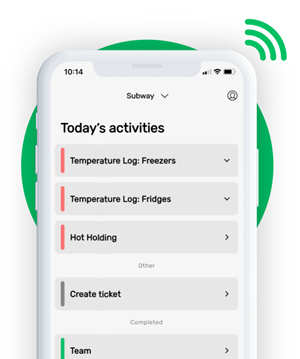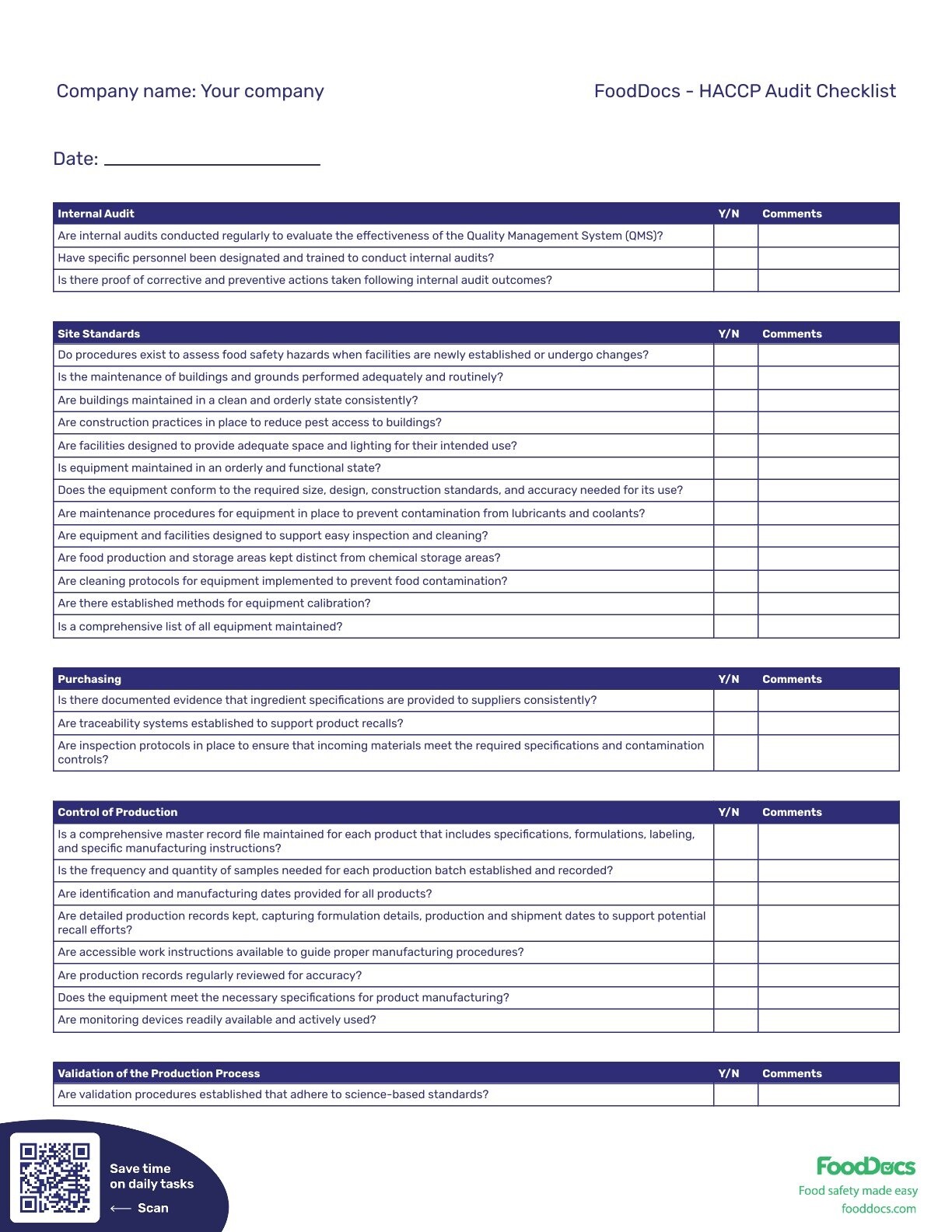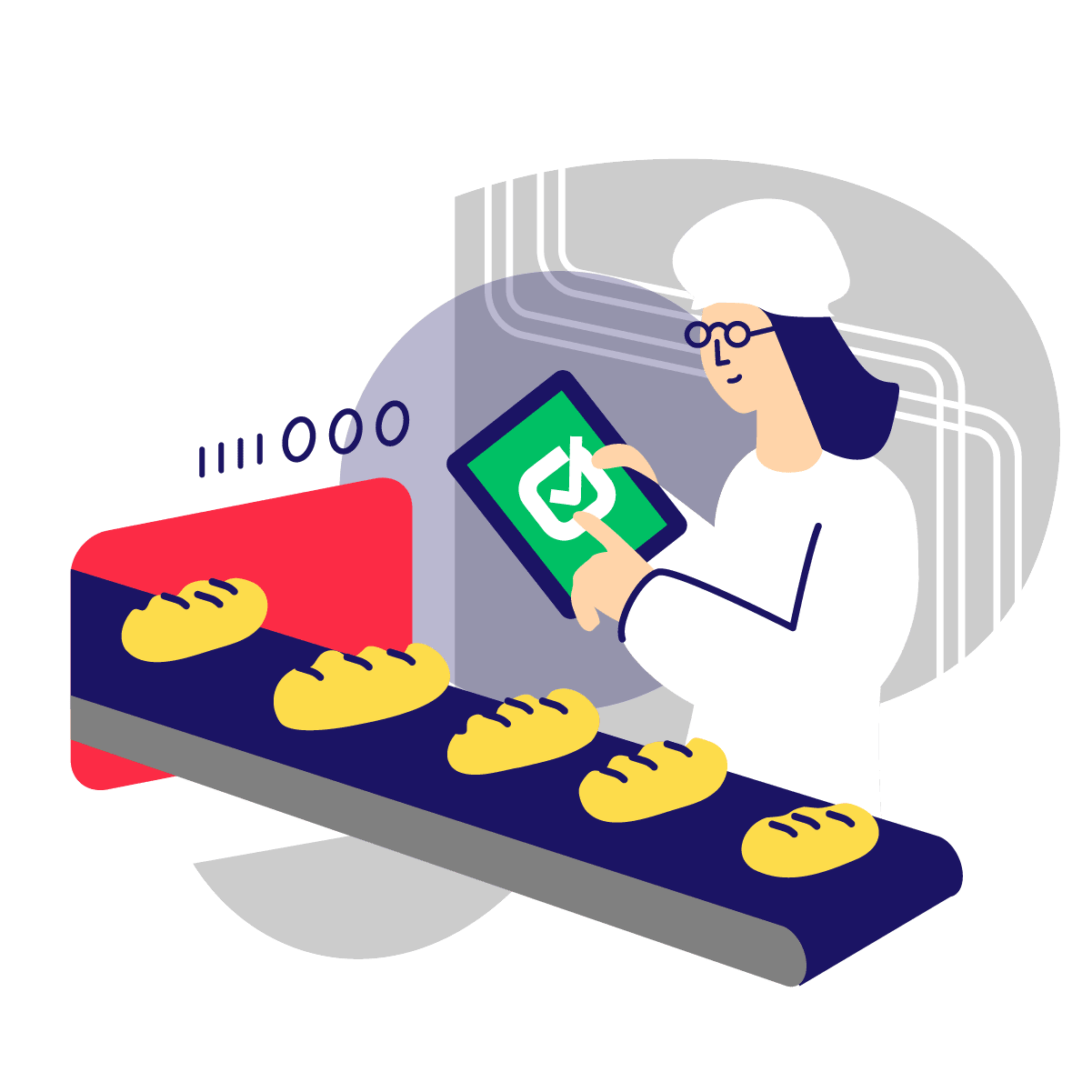RESTAURANT HEALTH INSPECTION CHECKLIST
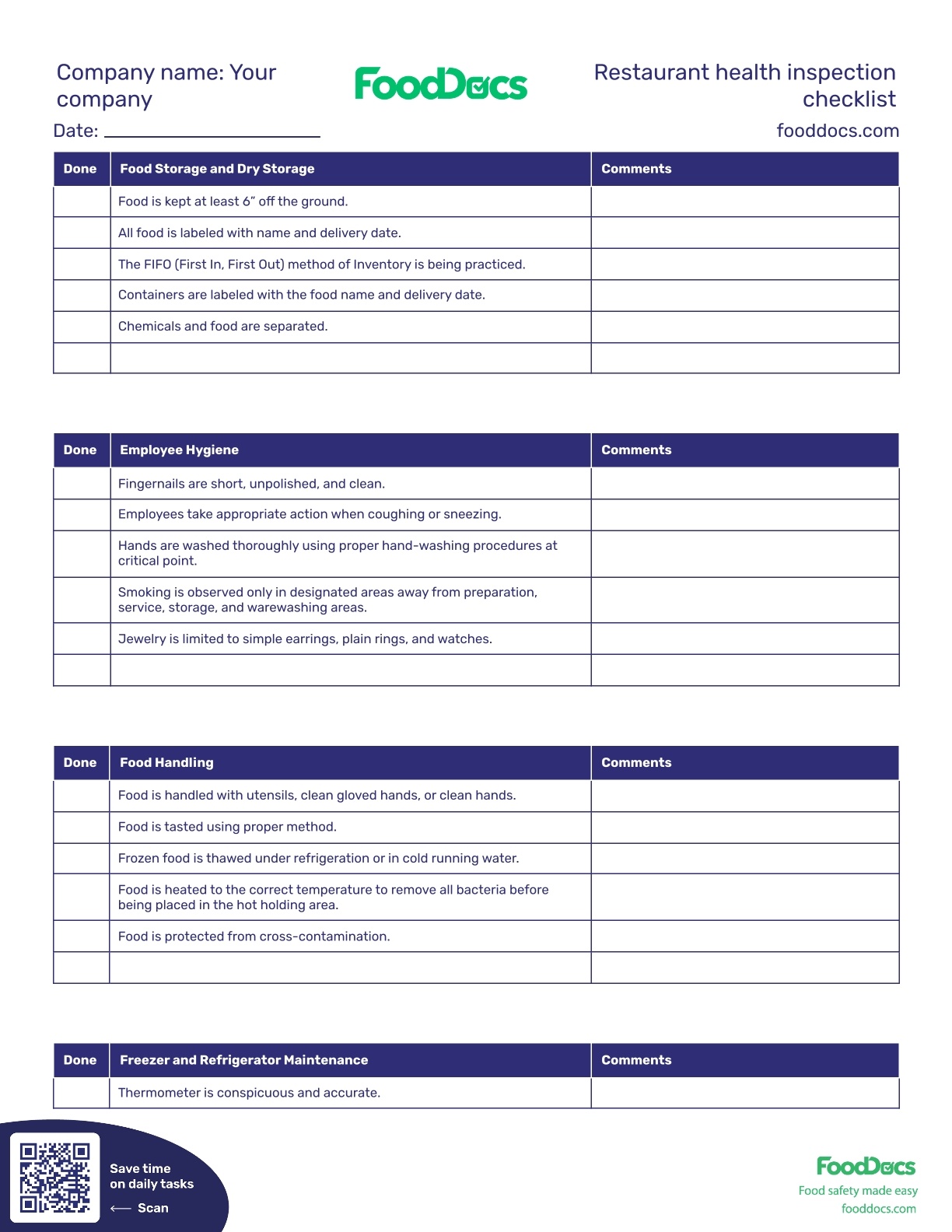



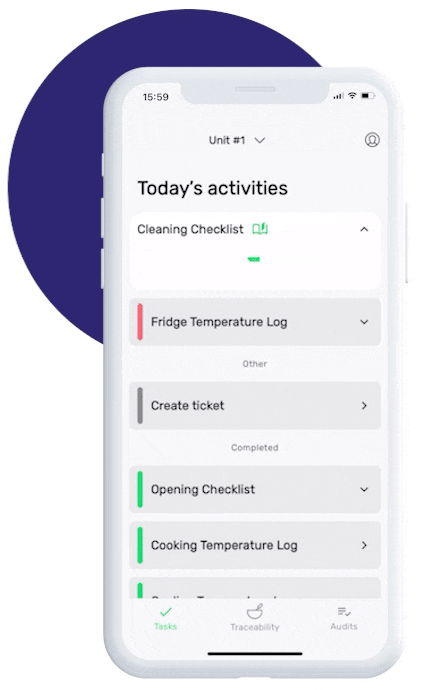
This is how our Digital Food Safety platform saves 20% of your time on daily tasks:
- Get upcoming task notifications
- Add data into the app
- Check the status of tasks in real-time

When food safety was still handled on paper, I typically spent a couple of hours per day getting the papers and going around checking or completing tasks… Now I can sit down and it's just all there in one place. It takes me 5-10 minutes.
Ruth B.
Store Manager
| Company name: Your company |  |
_ |
| Done | Food Storage and Dry Storage | Comments |
|---|
| Done | Employee Hygiene | Comments |
|---|
| Done | Food Handling | Comments |
|---|
| Done | Freezer and Refrigerator Maintenance | Comments |
|---|
| Done | Sanitation | Comments |
|---|
| Done | Garbage Disposal | Comments |
|---|
| Done | Pest Control | Comments |
|---|
What is a restaurant health inspection?
A restaurant health inspection is an official review by local health authorities to ensure your establishment follows food safety laws. Inspections protect customers from foodborne illness.
To pass, you must follow all safety rules: store, thaw, and cook food properly, and keep kitchens and storage areas clean. Failing an inspection can hurt your reputation and lead to fines or closure, so preparation is key.
Key takeaways
-
Restaurant health inspections are unannounced evaluations conducted by local authorities to ensure food safety and public health standards are followed.
-
Failing an inspection can lead to fines, closure, and reputational damage, especially since many health departments publish scores online.
-
Inspectors focus on food temperatures, hygiene, cross-contamination, cleanliness, pest control, and documentation, all of which must meet regulatory standards.
-
Restaurants should maintain a daily health inspection checklist that includes temperature logging, sanitation, and employee hygiene monitoring.
-
Cooking food to the correct internal temperature is one of the most cited violations, making thermometer calibration and use essential.
-
Public access to inspection reports increases transparency, builds customer trust, and encourages ongoing compliance among restaurant operators.
-
During an inspection, staff should walk with the inspector, fix minor issues immediately, and avoid obstructive or inappropriate behavior.
-
If a restaurant fails an inspection, they are usually given time to correct issues, but serious violations can lead to temporary closure.
-
Regular self-inspections, training refreshers, and equipment checks are among the best practices to stay inspection-ready year-round.
-
Treating every day like inspection day helps build a lasting food safety culture and protects both your customers and your business.
Why do health inspections matter for restaurants?
Inspections enforce food safety standards. A good score reassures customers, while failures damage trust and sales. Health inspectors exist to protect the public from food safety hazards like improper handling and contamination.
And given that many modern diners check inspection scores before choosing a restaurant, a failed inspection (often posted publicly) can send customers elsewhere and even lead to a forced shutdown until issues are fixed.
How often are restaurant health inspections?
Restaurant health inspections usually occur at least once per year. Many restaurants see a health inspector about 1–2 times a year, often on a semiannual schedule. Inspectors may arrive unannounced at any time (even before opening or near closing) to catch all routines.
High-risk establishments (busy kitchens, lots of raw handling) might be inspected more often (sometimes quarterly). In practice, assume the inspector could drop in on any day, so maintain standards every day.

What do restaurant health inspectors look for?
Inspectors focus on any conditions that could lead to foodborne illness. Key checkpoints include:
- Food storage and temperature: Are perishable foods kept at safe temperatures? Inspectors check refrigerator/freezer readings and logs. They ensure raw foods aren’t stored above ready-to-eat items (to avoid drips). Food should be labeled with dates and kept at least 6 inches off the floor (or more).
- Cooking and holding temperatures: Hot foods must reach safe internal temperatures, and cool-down practices must follow guidelines. (See table below for common cooking temp rules.) Inspectors often spot-check cooked food with a thermometer.
- Cross-contamination controls: Raw and ready-to-eat foods need separate utensils and prep areas. Cutting boards and tools should be color-coded or cleaned between uses to prevent mix-ups.
- Cleanliness and sanitation: All areas (kitchen, dining, restrooms) and equipment must be visibly clean. Inspectors will look for dirty surfaces, unwashed utensils, or clogged sinks. Dishwashing stations should be set up correctly (three compartments or a commercial machine), and sanitizer levels tested.
- Employee hygiene: Staff must wash their hands regularly and wear clean uniforms/hair restraints. No one with symptoms of illness should handle food. Gloves or utensils should be used to handle ready-to-eat items. Inspectors will notice if employees skip handwashing or violate dress codes.
- Pest control: Signs of rodents or insects (droppings, nests) are a big red flag. Doors and windows should close tightly. Garbage areas must be tidy. Any evidence of pests invites immediate violation.
- Documentation and training: Keep records of temperature logs, cleaning schedules, and staff food safety certifications on hand. Required permits, health ratings, and allergen information should be posted or accessible. Inspectors often ask staff about procedures to ensure they’re trained.
Together, these checks cover the most common violations in restaurants. Staying ready on each point can help you “act like every day is a health inspection day”.

How do you prepare a health inspection checklist for a restaurant?
Use an internal food safety audit checklist in daily practice. Assign tasks (opening, closing, weekly deep cleans) to make sure nothing is missed. Key preparation steps include:
- Regular cleaning schedules: Establish routines for daily, weekly, and monthly tasks. For example, have an opening checklist (check sanitizer levels, prep sinks) and a nightly cleaning list (sanitize surfaces, empty trash). Use a written list or digital log and review it together in staff meetings. Consistency is crucial.
- Food handler training and permits: Ensure all staff complete certified food safety training and carry required permits. Many areas require at least one certified handler on each shift. Better-trained staff make fewer mistakes on inspection day.
- Monitor health of staff: Require sick employees to stay home. Having ill workers handle food is a major risk. Encourage a culture where anyone feeling unwell reports symptoms.
- Supply tracking and maintenance: Keep working thermometers, test strips (for sanitizer), and log sheets at stations. Calibrate thermometers regularly. Replace any broken equipment immediately.
- Documentation: Keep up-to-date logs (temperatures, cleaning, restaurant pest control) and have copies of food safety plans or HACCP procedures if required. Showing months of logged checklists demonstrates diligence to inspectors.
- Self-inspections: Schedule your own audits. Ideally, have managers run through the inspection checklist weekly or monthly. Treat them as practice inspections. This habitual review makes official inspections less surprising.
Get a free internal HACCP audit checklist
What are the key restaurant health inspection checklist Items?
Below are some critical items to include on your routine checklist. Review them often:
- Food storage: Always store food ≥6″ off the floor and in covered, labeled containers. Keep raw meats below ready-to-eat foods. Check that refrigerator temperatures are below 40°F (4°C) and freezers are at 0°F (–18°C).
- Food preparation: Use separate cutting boards and utensils for raw meat and other foods. Wash and sanitize prep tools between uses. Thaw foods properly (in the fridge or under running water). Make sure all cooked dishes reach safe internal temperatures (see table below).
- Employee hygiene: Post handwashing signage. Have staff wash hands for ≥20 seconds after bathroom use, handling raw food, or touching face/cash. Require clean uniforms, hairnets/beard nets, and minimal jewelry. No eating or smoking in food areas.
- Facility and equipment: Ensure sinks (hand, mop, dishwashing) are accessible and functioning. Lighting must be adequate and fixtures covered. Floors and walls should be undamaged and clean. All chemicals are stored separately from food areas.
- Cleanliness: Sanitize surfaces after use. Verify dishwashers reach sanitizing temperatures or use test strips. Empty the trash before it overflows. Clean out coolers/freezers periodically.
- Pest prevention: Seal holes/cracks. Keep doors closed or screened. Maintain tight lids on the dumpster outdoors. Regularly conduct pest inspections for droppings or nests.
- Recordkeeping: Log temperatures for cooking, cooling, and cold storage daily. Keep copies of these logs readily available. Ensure food safety certificates are filed or displayed. Have your business license, food permit, and any posted health ratings current and visible.
By consistently checking these items, you reduce the chance of violating a critical code.
| Food Item | Minimum Cook Temp (°F) |
|---|---|
| Poultry (whole or ground), stuffing, leftovers reheated | 165 |
| Ground meats (beef, pork, poultry), seafood, eggs for hot-holding | 155 |
| Whole cuts of meat (beef, pork, lamb), fish, eggs (served soon) | 145 |
| Ready-to-eat hot-held foods (vegetables, grains, sauces) | 135 |
Table: Common internal cooking temperature guidelines (USDA standards).
What to do (and don't do) during a restaurant health inspection?
When the restaurant health inspector arrives, stay calm and professional.
Do:
- Verify credentials: Ask to see the inspector’s ID. Reputable inspectors provide it.
- Accompany the inspector: Walk with them to observe findings firsthand. If you spot a minor issue, fix it immediately. The report will note it as corrected on the spot, which is better than an out-of-compliance mark.
- Sign the report: This doesn’t mean you agree with all findings. It just proves you received a copy.
- Ask questions: If a violation is unclear, request an explanation. You can’t fix what you don’t understand.
Don’t:
- Don’t refuse or delay: Refusing entry can make things worse (inspectors can return with a warrant). Be cooperative.
- Don’t offer gifts or meals: Even polite gestures like offering coffee can be misconstrued as bribery. Stay cordial but neutral.
- Don’t hide or panic: Treat the inspection like another day. If violations are found, focus on correcting them.
Remember: inspectors want to protect customers, not punish you unnecessarily. By showing you’re informed and organized, you help ensure a fair review.
What happens after a restaurant's health inspection?
Once the inspection is complete, you’ll receive a score or grade. Some places use a 100-point system (higher is better), others use letter grades (A, B, C). In the UK, this is the equivalent of a food hygiene rating and their 5-point rating scheme. More important than the grade is the list of violations. Minor issues usually mean a follow-up visit, while major hazards mean fines or immediate closure.
- Minor violations: These are low-risk issues (e.g. a broken tile, one missing hand-wash sign). You’ll likely get time to fix them and a follow-up inspection soon. Often, there’s no fine if you correct the problem quickly.
- Major violations: These are serious risks (e.g. improper cooking temp, sewage backup). Expect a fine and possibly being shut down until fixed. In the meantime, customers may stay away, and your inspector will schedule a recheck.
If the health inspector found violations in your restaurant operations:
- Always address violations promptly
- Train staff on any mistakes found
If the inspector returns and you haven’t corrected critical issues, the health department can impose penalties.
Continued failure even risks permanent closure, and remember that reports of violations are usually public.
What happens if your restaurant fails a health inspection?
A “fail” means serious violations were found. You will typically have a set time to resolve them and welcome a re-inspection. If the problems remain, expect escalation: fines per violation and possible temporary closure. In the worst cases (severe health hazard), a restaurant may be ordered to close immediately until it meets standards.
For example, most jurisdictions follow up with failing restaurants rather than immediately shutting them down. After a routine inspection with issues, “the restaurant is given a chance to fix any issues… with a follow-up visit scheduled.” However, any major health risk (e.g., outbreak concerns) triggers swift action.
The key is not to panic. Fix what you can on-site and document your corrections. Then, prepare for the follow-up. Keeping detailed logs and past checklists can show inspectors that you are proactive.
Are restaurant health inspection reports accessible?
Yes, many health departments publish restaurant health inspection scores online. In places like New York City, Los Angeles, Washington D.C., and Chicago, customers can look up inspection grades on official portals. Florida’s restaurant data is available at MyFloridaLicense.com.
Being able to publicly access inspection reports is important for both restaurants and their customers. Here's why this access matters:
- Increases transparency for diners: Customers want to know if the food they’re eating is being prepared in a safe and sanitary environment. Public reports allow them to make informed choices based on real inspection data.
- Encourages better food safety practices: Knowing that your score is visible to the public and searchable online pushes restaurant staff and management to stay compliant at all times, not just on inspection day.
- Allows competitive benchmarking: Operators can review nearby restaurant scores to see how they compare. This helps identify what local inspectors are emphasizing or cracking down on.
- Helps build trust with your community: A history of clean inspections can be a marketing asset. It shows a long-term commitment to customer safety and can even influence online reviews.
- Supports accountability: When inspection scores are private, there’s less motivation to correct long-term problems. Public access holds businesses accountable and helps regulators enforce consistent standards across the board.

If you’re not sure where to find your local inspection reports, visit your city or county’s official health department website and search by business name or address.
What are the best practices and next steps for a restaurant health inspection?
The best way to pass a restaurant health inspection is to treat every day like it might happen. Instead of scrambling to clean or train staff last-minute, build a routine that makes inspection readiness a normal part of operations.
Here’s a breakdown of actionable best practices to follow:
Daily
- Use a prep and opening checklist to verify stations, temperatures, and sanitation supplies before service
- Log all cold-holding and hot-holding temperatures, including fridges, freezers, and hot food wells
- Clean and sanitize high-touch surfaces before, during, and after service
- Monitor employee hygiene (e.g. handwashing, glove use, proper uniforms)
- Inspect for pests (look for droppings, entry points, or food left uncovered)
- Check restrooms for cleanliness and working handwashing stations
- Review allergen protocols if applicable, especially for custom orders
Weekly
- Conduct a mini internal inspection using your local health department’s inspection form or your own version
- Calibrate thermometers and check sanitizer concentration with test strips
- Deep clean kitchen equipment like slicers, fryers, and ice machines
- Inspect food labels and shelf life dates, discarding anything expired
- Audit food storage areas for organization, cleanliness, and temperature control
Monthly
- Hold a food safety training refresher (15–30 minutes) with your team
- Inspect plumbing and ventilation systems for any signs of wear or damage
- Update documentation, including cleaning schedules, pest control logs, and staff certifications
- Invite a third-party auditor or manager from another location to conduct a mock inspection
Long-term improvements
- Build a food safety culture by making cleanliness and compliance part of your core values, not just a checklist
- Use digital tools (like food safety software or apps) to automate logging, alerts, and training reminders
- Encourage staff to report issues early so they can be fixed before becoming violations
- Celebrate clean inspections to motivate your team and reinforce the payoff of daily discipline
Following these best practices (which you can also find in our restaurant preventive maintenance checklist) consistently will help make inspections feel like a confirmation of your standards instead of a disruption to your workflow. That consistency is what sets compliant, customer-trusted restaurants apart.
How to always be prepared for restaurant health inspections with FoodDocs
Restaurant health inspections can make or break a restaurant’s reputation. A single poor score could turn away customers and lead to costly downtime. That’s why it pays to stay ahead of every inspection (and not just react to them).
FoodDocs makes it easy for restaurant teams to stay fully compliant and inspection-ready every day, without the paperwork. Our digital food safety management system is designed to help restaurants simplify daily monitoring, reduce errors, and pass inspections with confidence. And you can try it today with a 14-day free trial.
Automatically generated restaurant health inspection checklist
When you sign up, one of the first things FoodDocs builds is a digital Health Inspection Checklist tailored to your restaurant’s operations. It covers all the key focus areas inspectors evaluate (e.g., temperature logs, sanitation, food handling, and staff hygiene).
- Customize your checklist with your own daily or weekly tasks
- Choose between a pass/fail format or numerical grading
- Easily update items based on inspector feedback or changes to local regulations
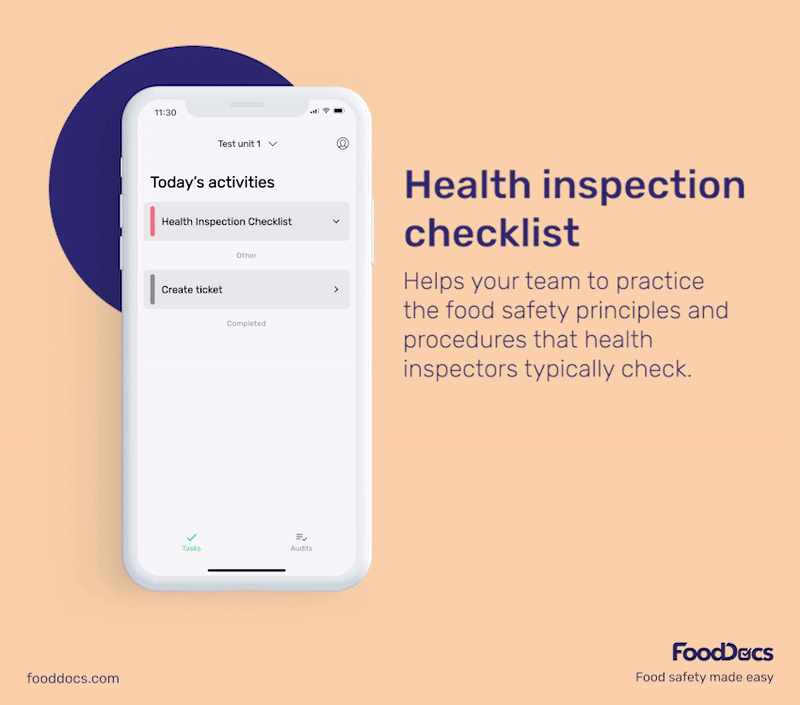
Built-in training instructions for food handlers
Each task in your checklist includes clear step-by-step instructions to guide your staff. Whether it’s setting up sanitizer buckets or logging hot-hold temperatures, your team will know exactly what to do and how to do it.
- Train new employees faster with visual or written instructions
- Keep tasks consistent across all shifts and locations
- Upload your own photos or videos to show your exact SOPs
Real-time dashboard for easier supervision
Instead of chasing checklists, managers get a live overview of all food safety activities. You’ll see which tasks are completed, which ones are overdue, and where to focus your attention — all from a single dashboard.
- Instantly spot non-compliance issues before an inspector does
- Track performance trends over time
- Use real data to coach your team and improve readiness

Digitize your entire food safety system in minutes
Getting started takes just 15 minutes. FoodDocs uses AI to build a food safety monitoring system based on your restaurant’s profile — no blank templates or starting from scratch.
- Replace your paper logs with smart, digital tools
- Set up custom monitoring tasks in just a few clicks
- Save hours every week on compliance paperwork
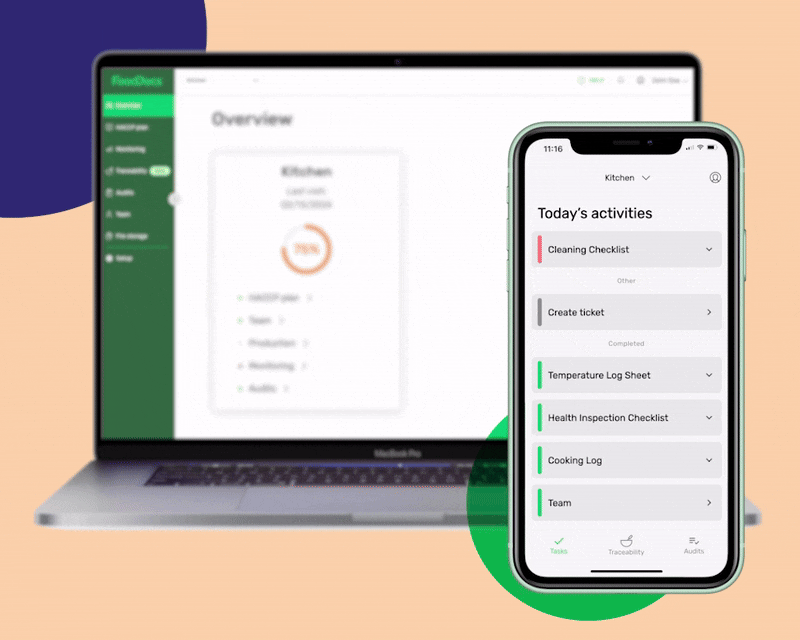
With FoodDocs, you can build a system that helps your team stay inspection-ready at all times, not just when an inspector walks in. Make food safety easier, more consistent, and more effective for your entire restaurant operation.
Impress your inspector and protect your reputation with FoodDocs.
Frequently asked questions about restaurant health inspections (and checklists)
What happens if a restaurant fails a health inspection?
A failure usually means serious violations. You’ll get a deadline to correct them. Minor fixes can often be made and re-checked, but unresolved issues may lead to fines or temporary closure.
Where can I find restaurant health inspection reports?
Most health departments post reports online. Look on your state or county health website (many have search tools), or major city portals (e.g., NYC, D.C.). For example, Florida’s inspection reports are available via MyFloridaLicense.com.
How often will my restaurant be inspected?
Typically once a year at minimum. Busy or high-risk kitchens often see inspections twice a year or more. Be prepared for surprise visits at any time.
What should I do when the inspector arrives?
Verify the inspector’s ID, walk with them through your operations, and be polite. Fix any minor issues on the spot (they’ll note it as corrected). Do not refuse entry or offer gifts. Sign the report when done, and ask questions about any unclear findings.
What are common violations inspectors cite?
Typical issues include improper food storage temperatures, cross-contamination (e.g., raw over cooked), unsanitary equipment or surfaces, poor personal hygiene, missing temperature logs, and evidence of pests. Using the checklist above can help you avoid these.
